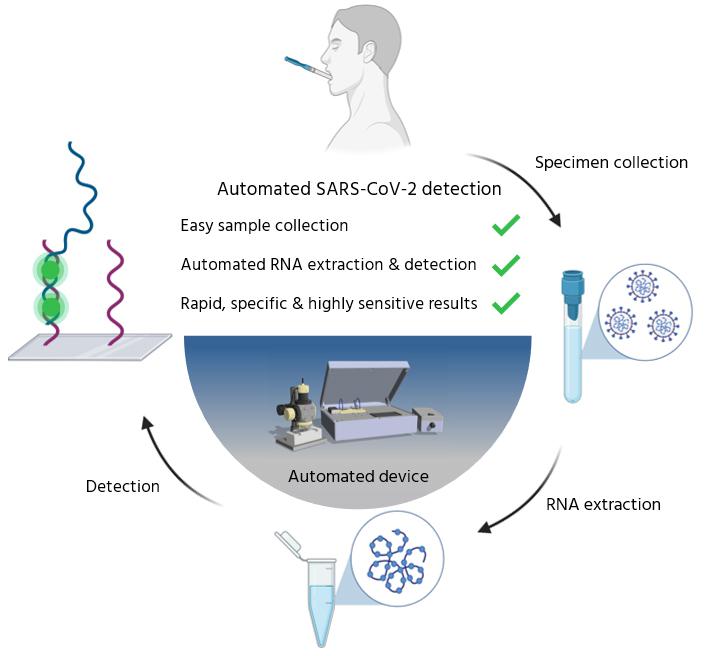A microfluidic for detecting SARS-CoV-2

The virus-detecting device. Credit: Sandrine Gerber-Lemaire.
A new microfluidic device developed by scientists in Switzerland can detect the SARS-CoV-2 virus with high accuracy and speed, using a unique DNA/RNA duplex technology. The device can prove to be a game-changer in the fight against the ongoing COVID-19 pandemic.
The ongoing COVID-19 pandemic created an urgent need for ways to detect the SARS-CoV-2 virusquickly, accurately and on a massive scale in order to control its spread.
Now, scientists from three Swiss institutions have developed a new microfluidic device that can detect SARS-CoV-2 with a high degree of accuracy. The device can distinguish SARS-CoV-2 from other respiratory viruses such as the Middle East respiratory syndrome coronavirus (MERS-CoV), making it a potential game-changer in the fight against coronaviruses. The project was led by Sandrine Gerber-Lemaire at EPFL, Igor Stefanini at SUPSI, and Francesco Bertoni at USI.
The device uses a DNA biosensor to detect RNA from SARS-CoV-2 in human saliva. When viral RNA binds to the DNA biosensor, it forms a DNA/RNA duplex. This is then detected by the sensor, which can pick up as little as 10 attomolar of the virus RNA. For perspective, one attomolar is equivalent to a drop of water in an Olympic-size swimming pool.
The device is based on microfluidics, a technology that controls the flow of very small amounts of liquids through tiny channels. With microfluidics, the new device controls the flow of saliva to allow the DNA biosensor to detect viral RNA. The DNA/RNA duplex is then detected with fluorescence measurements.

The virus detector can be deployed in non-medical environments, and can provide results in less than ten minutes, which makes it superb for point-of-care diagnostics in airports, schools, workplaces etc. And since it is highly selective for the SARS-CoV-2 virus, it does not produce false positives for other coronaviruses.
The device can play a significant role in population monitoring and mitigation efforts of the COVID-19 pandemic. It can also be adapted to detect other viruses with simple modifications to the sensor’s probe. “This device is highly versatile,” says Sandrine Gerber-Lemaire. “The biosensor unit can be easily adapted to the detection of other viruses by the selection and immobilization of other DNA probe sequences.”
Swiss National Science Foundation
Innosuisse
Perrine Robin, Laura Barnabei, Stefano Marocco, Jacopo Pagnoncelli, Daniele Nicolis, Chiara Tarantelli, Agatino Christian Tavilla, Roberto Robortella, Luciano Cascione, Lucas Mayoraz, Céline M.A. Journot, Mounir Mensi, Francesco Bertoni, Igor Stefanini, Sandrine Gerber-Lemaire. A DNA biosensors-based microfluidic platform for attomolar real-time detection of unamplified SARS-CoV-2 virus. Biosensors and Bioelectronics: X, 27 December 2022. DOI: 10.1016/j.biosx.2022.100302